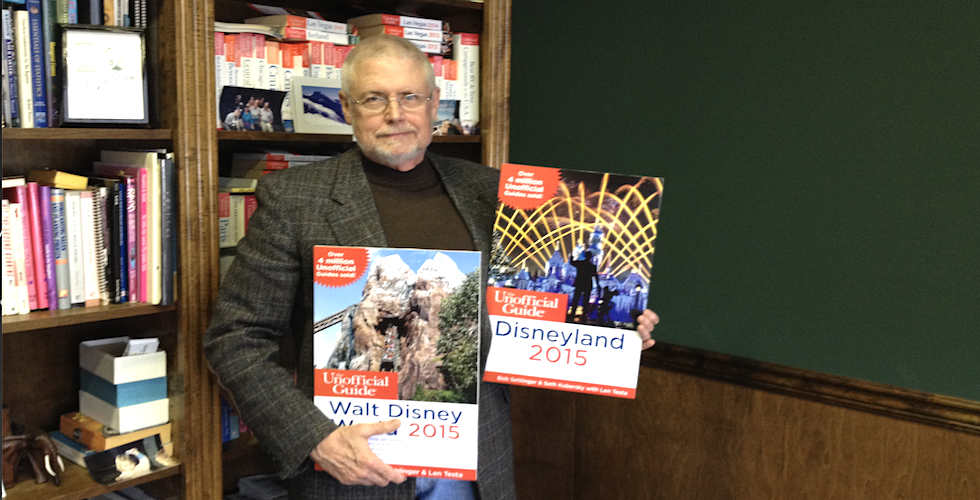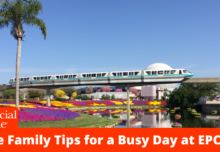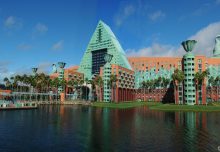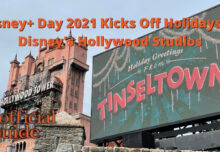Bob Sehlinger, author of The Unofficial Guide to Walt Disney World and creator of The Unofficial Guide Series, tells us about how his very first visit to Walt Disney World led him to writing the very first Unofficial Guide.

Currently, all theme parks, cruise lines, and other attractions are closed due to the COVID-19 pandemic. We at The Unofficial Guides hope all our readers and their loved ones, as well as all attraction employees, remain healthy and safe. Without intending to trivialize the current crisis, we will continue to post positive stories about the parks, in hopes of bringing their magic into your home as a welcome distraction during these trying times. For the latest updates, read our guide to cornoavirus and the theme parks.
In the early days, my company, Menasha Ride Press, was cash strapped, so I accepted a job on the faculty of Kentucky State University to teach marketing research and policy in the School of Business. I did this for about three years until the Press grew to the point where it could support me.
During a break from teaching, I took my son and daughter to Walt Disney World, which at that time consisted of the Magic Kingdom theme park, three resort hotels, and a campground. As it happened, this modest vacation launched me down a road that would totally change my life. Without any vacation planning, we descended on the Magic Kingdom and were immediately mired in incredibly long lines for the rides. After coughing up a veritable bucket of cash to get in, submitting to hours of waiting was maddening. On one day, we only experienced six attractions. It was a bummer, and we left the park tired and disappointed. Little did I realize that a busted vacation and some ruffled feathers would later turn me into a travel writer—or at least a travel curmudgeon.

Back at the University, I couldn’t help noodling ways to chop those Disney World lines down to size. My background in operations research (OR) figured prominently in many of the courses I taught. In case you’re not familiar with OR, it’s the application of mathematical modeling, statistical analysis, and mathematical optimization to arrive at the best solution possible to complex problems. If nothing else, avoiding long lines at Disney World was certainly a complex problem. It was the difference between a really fun day and an expensive downer. Other researchers later determined that a theme park patron’s satisfaction depended on the number of rides/attractions he/she experienced in a day.
I reasoned that if you knew guest traffic patterns throughout the day, as well as some information about the rides such as hourly capacity, how they load and unload, and how their lines are affected by neighboring rides and shows, it would be possible to create a model that would route you counter to the flow of the crowd and thus minimize your waits in line. I had the right idea, but making it happen was another story.
The main problem was that there were (and are) many ways to see the same attractions. For example, if you wanted to visit Space Mountain, Pirates of the Caribbean, and 20,000 Leagues Under the Sea (this was 1980) as soon as the Magic Kingdom opened, there were six ways to do so:
1. First ride Space Mountain, then ride Pirates of the Caribbean, then 20,000 Leagues Under the Sea.
2. First ride Space Mountain, then ride 20,000 Leagues Under the Sea, then Pirates of the Caribbean.
3. First ride 20,000 Leagues Under the Sea, then ride Space Mountain, then Pirates of the Caribbean.
4. First ride 20,000 Leagues Under the Sea, the ride Pirates of the Caribbean, then Space Mountain.
5. First ride Pirates of the Caribbean, then ride 20,000 Leagues Under the Sea, then Space Mountain.
6. First ride Pirates of the Caribbean, then ride Space Mountain, then 20,000 Leagues Under the Sea.
Some of these combinations make better plans than others. Since the line for Space Mountain builds quickly, it’s best to see Space Mountain first thing in the morning. For similar reasons, it would be better to see 20,000 Leagues Under the Sea before Pirates. In this example, plan number 2 would probably save you the most time standing in line. Plan 5 would probably result in the most waiting in line.

As we add attractions to our list, the number of possible plans grows rapidly. Adding a fourth attraction would result in 24 possible plans, since there are four possible variations for each of the six plans listed above. In general, the number of possible plans for n attractions is n x (n–1) x (n–2) x . . . x 1 (Don’t let the mathematical notation throw you. If we plug real numbers in, it’s quite simple.) For five attractions, as an example, there are 5 x 4 x 3 x 2 x 1 possible plans. If you don’t have a calculator handy, that adds up to 120 potential plans. For six attractions, there are 6 x 5 x 4 x 3 x 2 x 1, or 720 possible plans. A list of 10 attractions has over 3 million possible plans. The 32 attractions in the Magic Kingdom in 1980 had a staggering 263,130,836,933,693,530,167,218,012,160,000,000 possible plans. That’s over 263 decillion different combinations, or roughly 22 times more than the estimated number of stars in the Milky Way. Who knew?!
It was daunting for sure, but I was fairly certain that I could winnow the number down to something more manageable by understanding the rides and the park traffic flow. I began by identifying the most popular attractions where bottlenecks and long lines were most likely to occur. I reasoned that a plan that knocked those off in the first 30-60 minutes the park was open would free me up for the next three or four most popular attractions as the park moved into its second hour of operation, and that I could experience them with only moderate waits. I also identified attractions that were so efficient that you could enjoy them at any time without much of a wait. Good examples were the WEDway People Mover, the Walt Disney Railroad, and a couple of theater presentations such as Magic Carpet ‘Round the World in Tomorrowland. These I slotted after lunch when the park was most crowded. Some of the hardest to work into the plan were attractions that were extremely popular but, from an operational perspective, grossly inefficient. Dumbo was a prime example. It’s a must-do for children but can only accommodate a few hundred riders per hour. I tackled Dumbo and similar rides by developing two different plans, one for adults and children 11 years of age and older, and one for families with younger children. I also studied how certain attractions impacted neighboring attractions. When a show at the Hall of Presidents concluded, for example, it discharged several hundred people who inundated the nearby Haunted Mansion and Mike Fink Keelboats.
Today, most Disney World guests are repeat visitors who tend to head for their favorite attractions. Back then, however, the majority of the visitors were first-timers who attempted to see the park in some kind of orderly fashion. The largest percentage turned right at the end of Main Street USA into Tomorrowland. The rest split evenly between turning left into Adventureland or continuing straight to Fantasyland, to initiate their circuit of the park.

The Unofficial Guide to Disneyland 2015
By my next visit to Disney World I had cobbled together a couple of plans to test in the park. One of the most important things I did differently was to arrive at the turnstiles before the park opened. Theme parks fill up one person at a time. Right after opening there are lots of rides but not many people to go on them. In other words, you effectively have the park to yourself. Over the course of a busy day the situation flip-flops, so by 2 p.m. there are hoards of people vying to ride a comparatively small number of attractions.
I hadn’t yet developed a mathematical model to refine and underpin my intuitive plans, plans incidentally that were created for my family’s personal use, not for publication. The most important thing is they WORKED. We didn’t come near the efficiency of the sophisticated algorithm-based plans we have today, but compared to the experience of our first visit, they were super.

Over time I shared my touring plans with friends and family who enjoyed much success with them. One of the folks who used the plans was a friend from the publishing industry. He thought the plans could be the cornerstone for a travel guide. As it happened, I’d been thinking about that also, but not in the context of a guide to Disney World alone.
At the time, Florida tourism was centered in the southern part of the state. Even with Disney World, Orlando was more of a way-stop than a destination. Tourists would drop in for a day or two and then continue to Miami, Fort Lauderdale, or to the west coast for a beach vacation. If you looked at the Florida Attractions Association membership roster, there were many more attractions in Miami, Coral Gables, Fort Myers, and Sarasota than in the central part of Florida. Moreover, for a decade, Busch Gardens in Tampa had been perceived as a rough equal to the Magic Kingdom.
My concern at that time was that Walt Disney World had not achieved sufficient critical mass to warrant its own guidebook. I altered the concept, therefore, to a comprehensive approach where all the attractions in Florida were covered. There were too many attractions statewide to pack into one book, however, so we created three books: South Florida Attractions – A Consumer Guide; Central Florida Attractions – A Consumer Guide; and North Florida Attractions – A Consumer Guide. The sales of these guides graphically reflected the seismic shift in Florida tourism. The first year in print, South Florida Attractions outsold the Central and North guides. In year two, South Florida Attractions and Central Florida Attractions achieved parity. From then on Central Florida outpaced its sister titles by an ever-widening margin, indicating Walt Disney World’s transition from a stop-over to a destination. It was at this point that I felt comfortable developing a stand-alone guide to Disney World.
Be sure to follow us on Twitter, Facebook, Instagram, and YouTube. If you enjoyed this post, sign up for our newsletter here.
2 Comments
-
Can u help me with a plan for arriving a MK at 4 o’clock on October 17, 2024 for the Not So Scarry Halloween party,?? We have opted to not get a pass for the day at MK and do the Halloween party instead, but would like our grsnfaughter to do redes that evening befor the party.
-
Dear Patricia: If you buy tickets for MNSCHP you do indeed have access to the parks as of 4 p.m. We recommend you be there right at 4 p.m. and make sure you pick the rides you want your granddaughter to experience and ride as many as you can before the party starts.
Once you arrive at the entrance, go to the right side of the park. Cast members are there handing out wristbands for partygoers. The line can be long, so arrive early, but even though lines are long at that particular entrance, the line moves quickly. Make sure to pick up the special MNSSHP map that lists all entertainment.
The party officially starts at 7 p.m. The park closes for regular guests at 6 p.m. At that time, Disney will NOT allow daytime guests on any rides as they are clearing the park from daytime guests. If you are not able to do some rides prior to the start of the party, this is a good time to line up at the entrance of the ride.
Rides typically open during MNSSHP:
Jungle Cruise
Pirates of the Caribbean
The Magic Carpets of Aladdin
Swiss Family Treehouse
Big Thunder Mountain Railroad
Haunted Mansion
Prince Charming Regal Carrousel
It’s a Small World
Peter Pan’s Flight
The Many Adventures of Winnie the Pooh
Mad Tea Party
Under the Sea ~ Journey of The Little Mermaid
Seven Dwarfs Mine Train
Dumbo the Flying Elephant
The Barnstormer
Astro Orbiter
Buzz Lightyear’s Space Ranger Spin
Monsters, Inc. Laugh Floor
Space Mountain
Tomorrowland Speedway
Tomorrowland Transit Authority PeopleMover
TRON Lightcycle / RunPlease note: Genie+ is NOT available during MNSSHP.
Save Trick-or-Treating for later that night. There is PLENTY of candy!Trick-or-treat stations that are usually at MNSSHP:
Pinocchio Village Haus
Mickey’s PhilharMagic
Gaston’s Tavern
Ariel’s Grotto
Cosmic Ray’s Starlight Café
Near TRON Lightcycle / Run
Walt Disney’s Carousel of Progress
Monsters, Inc. Laugh Floor
Market Street (It oftencloses at 8 p.m.)
Chamber of Commerce (allergy-friendly station; available until 12:30 a.m.)
Walt Disney’s Enchanted Tiki Room
Tortuga Tavern
Sawyer Island dock, near the Big Thunder Mountain ride
Country Bear Jamboree
Liberty Square
Liberty Square Ticket Office. This is usually the allergy-friendly station and it is open till the park closes.Must do/see:
Mickey’s Boo-To-You Halloween Parade runs twice per night
Hocus Pocus Villain Spelltacular presented at the castle forecourt 4 times the day you are visitingSpecial Characters:
This is really tricky to plan. Long lines often start as soon as MNSSHP guests are let into the park, especially for The Seven Dwarfs and Skellington & Sally. If it is really important for your granddaughter, go for it, but it is a major loss of time. You can see all of the characters during the Boo=To=You parade.I hope this is helpful to you.
Best,
Liliane
-





